History of the Evolution of Aggressive "Body Position"
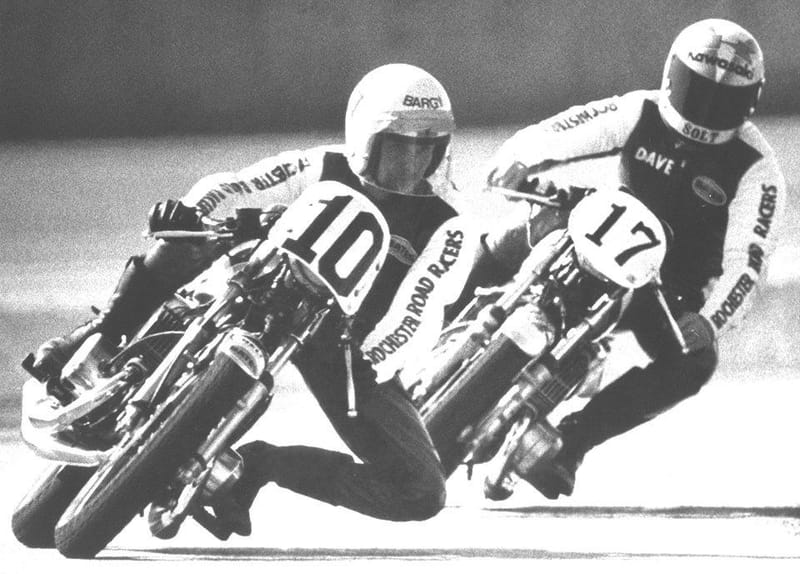
The Actual History of Body Position Evolution
I see a lot of postings on the social medias about body position or "BP". I have noticed a wide range of misconceptions about what hanging off or BP actually does and why riders hang off in the first place. Anyone looking at the pictures of the top riders of the past several decades will see an evolution in the style and aggressiveness of body position of the road racer.
Also, I have noticed a lot of new riders, when looking at the photos, are confusing "style" with "function". Where style has very little input on the performance of the bike, style is more of a compensation for each riders' own physiology, flexibility etc. Function on the other hand is the actual movement of body weight to accomplish a specific goal.
When the younger riders of today look at the pictures, they try to deduce why the rider is hanging off and what it is accomplishing. Since these new riders have never ridden the bikes of the 60s, 70s, 80s and 90s they have no clue of why we had to hang off and why it has gotten more aggressive as time goes on. I have even heard some new riders say that racers are faster today mainly because they hang off more than in the past.
As a racer myself with over five (5) decades in the sport and have raced those bikes, I have been personally involved during the evolution of BP. I would like to correct the misconception that, racers are faster today because of more aggressive BP. "Today's racers are not faster because of extreme BP. They have extreme BP because they are faster." The advances in racing are not a result of more aggressive BP but the opposite is true. As tires got better, BP got more aggressive
"BP Evolution Follows a Direct Correlation to Advancements in Tire Technology"
In the big picture, the advances road racing has always been a battle between traction and ground clearance.
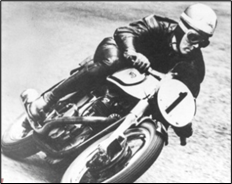
Let's start from the early days in the 50s. When you look at the photos from the 50's you will see that the racers are not leaned over very far and not hanging off at all. The reason for that was the lack of good sticky tires. Racers could easily use up all of the available traction long before they ran out of ground clearance. Once they start to slide, they were going as fast as they could go. Trying to hang off those bikes would be an exercise in futility and a waste of time and effort.
Rule # 1, "There is no magic way to sit on a bike to get more traction"
If we now move into the 60s there was a small improvement in tire design. The increase in traction allowed some riders on certain bikes to just barely run out of ground clearance at the same instant they used up all the traction. We will see a slight change in the BP. Riders started to throw out their inside knee a little. This knee out would cause the bike to straighten up just enough to keep the exhaust pipes from dragging.
I personally went through this with my 1959 BSA Super Rocket in England. When I would be dragging my pipes, I found by moving a small amount of my weight to the inside, I would now have enough ground clearance to go a little faster and use up the extra traction from the better tire. After that I noticed, when I would start to slide the tire, any more aggressive BP had no further beneficial effect.
In the early 70s there wasn't much improvement in the grip of the motorcycle racing tire from the mid-60s. On the other hand, there was a drastic reduction in the ground clearance with the introduction of "Box Stock, Production" classes with the multi-cylinder two stroke motors such as the Kaw triples and Suzuki's and then the four cylinder Hondas. These bikes had more and fatter pipes hanging off the bottom. These classes also required us to run DOT tires not racing slicks. The reduction in ground clearance made it was quite common to drag hard parts long before we ran out of traction, even with non-racing tires.
In order to go faster we realized we needed to stand the bike up a little more than in the mid to late 60s. We found by hanging more of our body off to the inside we would gain the extra ground clearance, now we could go faster and use up all the extra clearance. At the same time, we noticed that the narrower production bikes like the 2 cylinder Yamahas had more clearance and didn't drag their pipes as soon. The result was that the Yamahas could corner just a little faster, before dragging their pipes, without hanging off.
This is when we started to experiment with different BPs. (When I say "we" I'm referring to myself and one or two of my teammates at the time. I can't vouch for what other racers or teams were doing at that time) We wanted to find out which BP would result in the best gain in clearance. We could put the bike into a turn fast enough and leaned over just enough for the pipes to be just barley scraping. While maintaining a constant speed and radius, we moved into a different posture. As we changed position, we would quickly notice if the pipes would drag harder or if we gain clearance.
We found ourselves trying basically two different postures.
One position was to keep our butt on the seat and move our head and shoulders into the turn. As shown in this early caricature. 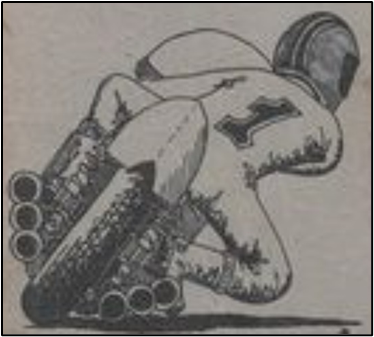 This was a first incarnation of Body Position experiments by the racers of that time. It was quickly abandoned because it was found to be, not very effective for reducing lean angle.
This was a first incarnation of Body Position experiments by the racers of that time. It was quickly abandoned because it was found to be, not very effective for reducing lean angle.
This is another example of what I say, “There is really nothing new in the sport.” Just old ideas recycled time and again by new riders.
The other posture we tried, was to keep our head centered and slide our butt and leg off to the inside. Repeatedly, the results showed greater reduction of lean angle than the head and shoulder position, shown above. We also found we preferred the butt off BP because, it kept our hands and arms in a comfortable “ARM POSITION” and afforded us the most precise control of the bike, as shown in the photo of bike 10 & 17 above, We also found that, the head & should position compromised our feel and control of the bike.
Repeatedly, the results showed greater reduction of lean angle than the head and shoulder position, shown above. We also found we preferred the butt off BP because, it kept our hands and arms in a comfortable “ARM POSITION” and afforded us the most precise control of the bike, as shown in the photo of bike 10 & 17 above, We also found that, the head & should position compromised our feel and control of the bike.
After we got comfortable cornering while hanging off we tried slight changes in PB. Once again we would put the bike into a turn with the pipes just barely scraping. We would then try changing our position, one is sitting up with our heads up the other was to go into a tuck with our head down (often referred to as “Kiss the Mirror” position). The result was when we had the pipes scraping while our head was up then bent down into the tuck head down position, the dragging of the pipe actually got worse. If we stated with our head down and just scraping then sat up, the scrapping would stop.
We concluded that head up gave use the best clearance. We also concluded it was how far "off center" to the right or left you moved your weigh which had the biggest impact on the lean angle of the bike. Moving our weight up or down had the least, if any, impact on lean angle and is more a matter of "Style as opposed to Functionality".
As production class racers we had to develop our PB several years before what we called the "GP" riders had to.  The GP riders were riding the factory built road race bikes such as the Yamaha TD, TA or the TZ series. These bikes had lot more ground clearance to start with. They also had the current "Racing tires" with a whole lot more traction than the DOTs we were riding. The better clearance allowed them to lean a lot more before scraping hard parts. Even into the late 70s and early 80s, with a few exceptions, the result is they would run out of traction before they ran out of clearance. As mentioned above, once the traction was used up any further increase in BP was exercise in futility and a waste of time and effort.
The GP riders were riding the factory built road race bikes such as the Yamaha TD, TA or the TZ series. These bikes had lot more ground clearance to start with. They also had the current "Racing tires" with a whole lot more traction than the DOTs we were riding. The better clearance allowed them to lean a lot more before scraping hard parts. Even into the late 70s and early 80s, with a few exceptions, the result is they would run out of traction before they ran out of clearance. As mentioned above, once the traction was used up any further increase in BP was exercise in futility and a waste of time and effort.
By the time we get into the late 80s and early 90s tires had gone through a major improvement. The racing tires were now developing estimated 1.2 - 1.3+ Coefficient of Friction (CF), compared to 1.1-1.2CF of the previous years. 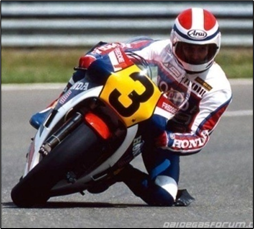 With the improved tires the riders were once again going fast enough to run out of clearance before traction. The result was the BP had to get more aggressive to get the hard parts off the ground to go faster and use up the extra traction. As you can see there isn't much difference between what we were doing in the 70s compared to what the GP boys were doing in the 90s. Just they were leaned over more because of better tires.
With the improved tires the riders were once again going fast enough to run out of clearance before traction. The result was the BP had to get more aggressive to get the hard parts off the ground to go faster and use up the extra traction. As you can see there isn't much difference between what we were doing in the 70s compared to what the GP boys were doing in the 90s. Just they were leaned over more because of better tires.
Tires, bike chassis, clearance and BP kept evolving together over the past couple of decades. Current race bikes can go markedly faster. Looking at a top world class rider of this generation you will see and extremely aggressive BP.
In this photo below notice his full max lean angle. You can easily see that he has used up all of his clearance. 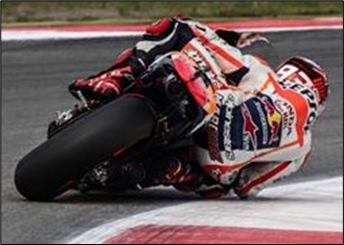 If he weren’t hanging off as much, as he is, he would be dragging all sorts of hard parts and not be able to go as fast or even crash. He has to be aggressive in his BP. Contrary to current belief, you can see the bike isn’t straightened up so much that it is on a fatter part of the tire. It is all the way to the edge. As long as you have traction, leaning to full lean is not the danger. “To go fast you will have to lean!”
If he weren’t hanging off as much, as he is, he would be dragging all sorts of hard parts and not be able to go as fast or even crash. He has to be aggressive in his BP. Contrary to current belief, you can see the bike isn’t straightened up so much that it is on a fatter part of the tire. It is all the way to the edge. As long as you have traction, leaning to full lean is not the danger. “To go fast you will have to lean!”
"Hanging Off Doesn't Make Him Fast. Going Fast Makes Him Fast. He Is Hanging Off Because He Needs To." "Aggressive BP Is the RESULT of Going Fast Not the CAUSE"
There is one other detail about BP that comes into play when racing. It has to do with the weight of the rider and bike combined. The bikes weigh a specific amount; the riders come in all sizes and shapes. The object of hanging off is to move highest percentage of the combined weight to the inside of the turn. The more weight that is moved and the further it is moved, the more the bike straightens up. A large rider, about 200 – 250+lbs on a light weight 600 can move a higher percentage of combined weight off center that a 130 - 140lbs rider on a heavier, full sized 1000 bike. In effect the heavier rider doesn't need to be as aggressive with his BP as a small light weight rider to get the same results.
In conclusion, Body Position has evolved in a direct parallel to advances in tire technology. As tires got better BP had to get more aggressive. If today's riders rode the bikes of the 70s and 80s their BP would not be as aggressive as it is today.
In closing, If, you are a new rider, use as much BP as you need for the speed you are riding. 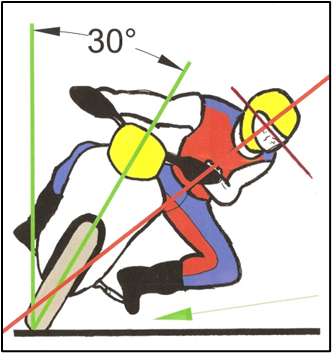 Over aggressive is unnecessary and waste of you learning time. You don't need to be over aggressive like this unnamed rider in this sketch.
Over aggressive is unnecessary and waste of you learning time. You don't need to be over aggressive like this unnamed rider in this sketch.
For more information about Body Position read
"Problems with Observational Interpretations"